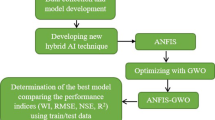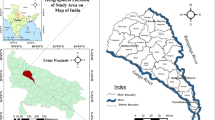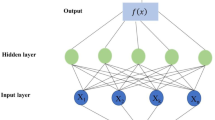Abstract
The potential of grey self-memory model (GSM), radial basis function network (RBF), and adaptive neuro fuzzy inference system (ANFIS) models in forecasting groundwater depths over an unconfined aquifer was compared. GSM, RBF, and ANFIS modeling was carried out at five sites in Jilin City, northeastern China, considering the influential lags of monthly groundwater depth as the inputs. The performance of the models was evaluated using criteria standards (R, RMSE, MARE, NS) and graphical indicators. Results indicate that the performance of all models was satisfactory in the region which lack of hydro-meteorological data. Comparison of the goodness-of-fit statistics in the research indicated that ANFIS was the better technique than the other two at all the sites except for J21, and GSM(1,1) was the worst model at all the sites. However, considering the practical advantages of GSM(1,1) technique, it was recommended as an alternative and cost-effective groundwater modeling tool. Meanwhile, it was found that the modeling prediction for the well with the stable and evenly distributed data series has more accurate fitting results, generally.






Similar content being viewed by others
References
Ahmed AN, Elshafie A, Karim O, Jaffar O (2009) Evaluation the efficiency of radial basis function neural network for prediction of water quality parameters. Engineering intelligent systems for electrical engineering and communications 17(4):221–231
ASCE Task Committee (2000) Artificial neural network in hydrology. J Hydrol Eng 5(2):142–137
Cao HX (1993) Self-memorization equation in atmospheric motion (in Chinese). Sci China Ser B 23(1):104–112
Cao HX (2002) Memorial dynamics of systems and its applications. Geology Publishing House, Bei**g (in Chinese)
Cao HX, Gu XQ (2001) The improve of the medium-term circulation forecasting with self-memorization spectrum model (in Chinese). Progr Natl Sci 11(3):309–312
Cao HX, Feng GL, Wei FY et al (1999) Self memorial model of climate prediction and its prelimimary application (in Chinese). Chin J Comp Phys 16(2):206–210
Chen L-H, Chen C-T, Pan Y-G (2010) Groundwater level prediction using SOM-RBFN multisite model. J Hydrol Eng 15(8):624–625
Denaï MA, Palis F, Zeghbib A (2007) Modeling and control of non-linear systems using soft computing technixues. Appl Soft Comput 7(3):728–738
Deng J (1985) Grey system—society and economics (in Chinese). National defence industry press, Bei**g
El Shafie AH, El Shafie A, Almukhtar A, Taha MR, El Mazoghi HG, Shehata A (2012) Radial basis function neural networks for reliably forecasting rainfall. Journal of water and climate change 3(2):125–138
Ghose DK, Panda SS, Swain PC (2010) Prediction of water table depth in western region, Orissa using BPNN and RBFN neural networks. J Hydrol 394:296–304
Govindaraju RS, Rao AR (2000) Artificial neural networks in hydrology. Kluwer, Dordecht, Amsterdam
Guo R (2005) Repairable system modelling via grey differential equations. Journal of Grey System 8(1):69–91
Jang JSR (1993) ANFIS: adaptive-network-based fuzzy inference system. Syst Man Cybern IEEE Trans 23(3):665–685. doi:10.1109/21.256541
Jang JSR, Sun CT (1995) Neuro-fuzzy modeling and control. Proc IEEE 83:378–406
Kagoda PA, Ndiritu J, Ntuli C, Mwaka B (2010) Application of radial basis function neural networks to short-term streamflow forecasting. Phys Chem Earth 35(13–14):571–581
Keskin ME, Terzi Ö, Taylan D (2004) Fuzzy logic model approaches to daily pan evaporation estimation inwestern Turkey/Estimation de l’évaporation journalière du bac dans l’Ouest de la Turxuie par desmodèles à base de logixue floue. Hydrol Sci J 49(6):1001–1010. doi:10.1623/hysj.49.6.1001.55718
Kisi Ö (2006) Daily pan evaporation modelling using a neuro-fuzzy computing technixue. J Hydrol 329:636–646
Krishna B, Rao YRS, Vijaya T (2008) Modeling groundwater levels in an urban coastal aquifer using artificial neural networks. Hydrol Process 22:1180–1188
Li RF, Shen B, Zhang JK (2005) Self-memory model for predicting groundwater depth series with periodical fluctuation. Transactions of the CSAE 21(7):34–37
Luk KC, Ball JE, Sharma A (2000) A study of optimal model lag and spatial inputs to artificial neural network for rainfall forecasting. J Hydrol 227:56–65
Rajaee T (2011) Wavelet and ANN combination model for prediction of daily suspended sediment load in rivers. Sci Total Environ 409(15):2917–2928
Sahoo S, Jha MK (2013) Groundwater-level prediction using multiple linear regression and artificial neural network techniques: a comparative assessment. Hydrogeol J 21:1865–1887
Shanker M, Hu MY, Hung MS (1996) Effect of data standardization on neural network training. Int J Mange Sci 24:385–397
Shen B, Liu M, Huang LM (2006) Grey self-memory model and i ts applica tion in the prediction of groundwater depth in Hotan, **njiang. Jour Of Northwest Sci-Tech Univ of Agri And For (Nat Sci Ed) 34(11):223–226
Shu C, Ouarda TBMJ (2008a) Regional flood frequency analysis at ungauged sites using the adaptive neuro-fuzzy inference system. J Hydrol 349:31–43
Sinnakaudan SK, Ghani AA, Ahmad MSS, Zakaria NA (2006) Multiple linear regression model for total bed material load prediction. J Hydraul Eng ASCE 132(5):521–528
Sreekanth PD, Sreedevi PD, Ahmed S, Geethanjali N (2011) Comparison of FFNN and ANFIS models estimating groundwater level. Environ Earth Sci 62:1301–1310
Talei A, Chua LHC, Wong TSW (2010) Evaluation of rainfall and discharge inputs used by adaptive network-based fuzzy inference systems (ANFIS) in rainfall–runoff modeling. J Hydrol 391:248–262
Trichakis IC, Nikolos IK, Karatzas GP (2009) Optimal selection of artificial neural network parameters for the prediction of a karstic aquifer’s response. Hydrol Process 23:2956–2969
Tsoukalas LH, Uhrig RE (1997) Fuzzy and neural approaches in engineering. Wiley-Interscience, New York, p 587
Vahid M, Mehdi V, Bagher S, Negin B (2013) A wavelet-ANFIS hybrid model for groundwater level. Water Resour Manag 27:1301–1321
**a J (1988) Identification of DHGM model and real-time grey forecasting (in Chinese). J China Hydrol 1:1–7
Yuan J, Yang ZY, Shi XL, Yan DH (2013) Differential hydrological grey self-memory model for runoff simulation and prediction. J Hydraul Eng 44(7):791–799
Acknowledgements
This study was funded by the Tackling-key Project of Jilin Department of Science and Technology (20100452) and the Science Foundation Project of Jilin Province (20140101164JC). The opinions expressed here are those of the authors and not those of other individuals or organizations. The constructive comments and suggestions from the editor and anonymous reviewers, which resulted in a significant improvement of the manuscript, are gratefully appreciated.
Author information
Authors and Affiliations
Corresponding author
Rights and permissions
About this article
Cite this article
Zhang, N., **ao, C., Liu, B. et al. Groundwater depth predictions by GSM, RBF, and ANFIS models: a comparative assessment. Arab J Geosci 10, 189 (2017). https://doi.org/10.1007/s12517-017-2954-8
Received:
Accepted:
Published:
DOI: https://doi.org/10.1007/s12517-017-2954-8




